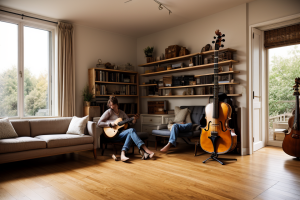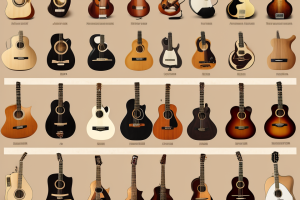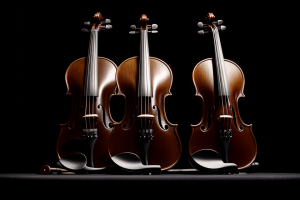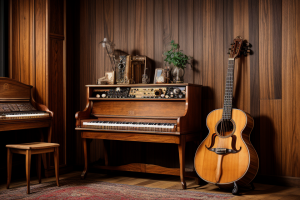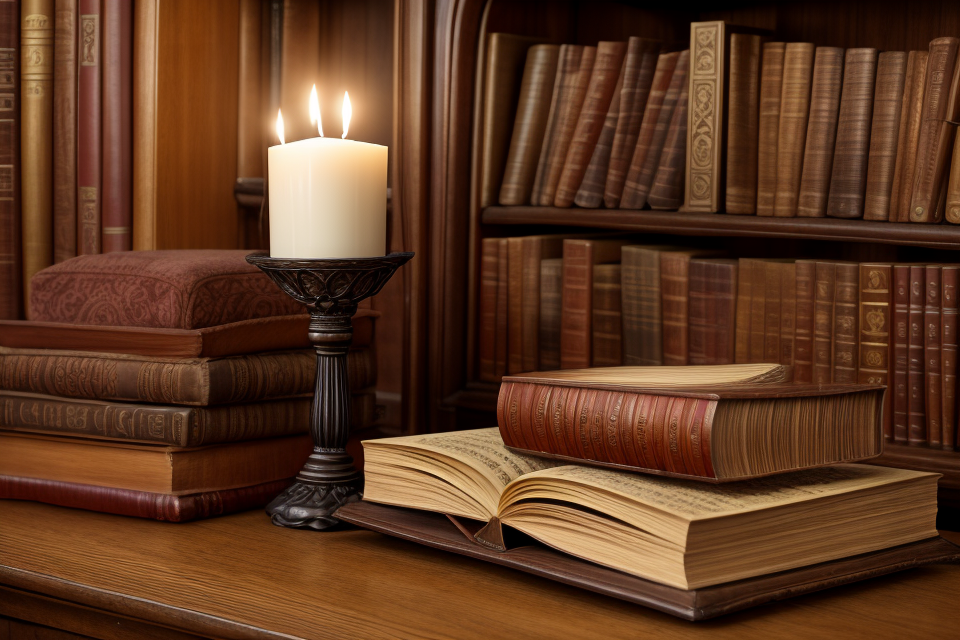
As wooden musical instruments are made of delicate woods, preserving them requires a specialized approach. Proper care and maintenance can help protect your instrument and extend its lifespan. This guide will cover the essential steps for preserving wooden instruments, including cleaning, humidification, and protection from damage. By following these tips, you can ensure that your wooden instrument remains in excellent condition for years to come. So, let’s get started!
Understanding the Importance of Wooden Instrument Preservation
The Significance of Wooden Instruments in Music
Wooden musical instruments have been an integral part of music-making for centuries. Their unique sound and timbre have made them a popular choice among musicians and composers alike. The use of wood in musical instruments dates back to ancient civilizations, where instruments such as the lute and the harp were crafted from wood. Today, wooden instruments are still widely used in various genres of music, including classical, jazz, and folk.
One of the primary reasons why wooden instruments are so popular is their ability to produce a rich, warm sound. The density and grain of the wood used in the instrument’s construction can significantly impact the sound quality. For example, the soundboard of a piano is typically made from spruce or maple, which are lightweight and rigid, allowing the piano to vibrate freely and produce a clear, resonant tone. Similarly, the body of an acoustic guitar is usually made from mahogany or rosewood, which provide a warm, bassy sound.
In addition to their unique sound, wooden instruments are also valued for their aesthetic appeal. Many wooden instruments are beautifully crafted and decorated, making them works of art in their own right. For example, violins and cellos often have intricate inlays and decorations on their fretboards and bodies, adding to their visual appeal.
Overall, wooden musical instruments are an essential part of the music world, and their preservation is crucial to ensuring that they can continue to be enjoyed by musicians and audiences alike for generations to come.
The Risks of Improper Preservation
Improper preservation of wooden musical instruments can lead to several risks that can affect their structural integrity, sound quality, and overall value. Here are some of the potential risks associated with improper preservation:
- Cracking and Warping: Wooden instruments are susceptible to cracking and warping when they are exposed to extreme changes in temperature and humidity. Improper preservation can cause the wood to shrink or expand, leading to cracks and deformations that can affect the instrument’s sound quality and playability.
- Deterioration of Finish: The finish on wooden instruments is designed to protect the wood and enhance its appearance. However, exposure to dust, moisture, and other environmental factors can cause the finish to deteriorate, leading to discoloration, scratches, and other damage.
- Increased Susceptibility to Pests: Wooden instruments are also vulnerable to pest infestations, such as termites and woodworms. Improper preservation can create an ideal environment for these pests to thrive, causing extensive damage to the instrument’s structure and sound quality.
- Loss of Value: Proper preservation is essential to maintaining the value of wooden musical instruments. Improper preservation can lead to significant damage that can reduce the instrument’s value and make it difficult to sell or trade.
In conclusion, the risks of improper preservation of wooden musical instruments are significant and can lead to long-term damage that affects the instrument’s structural integrity, sound quality, and overall value. It is essential to understand these risks and take appropriate measures to properly preserve wooden musical instruments to ensure their longevity and performance.
Common Causes of Damage to Wooden Musical Instruments
Environmental Factors
Wooden musical instruments are susceptible to damage from various environmental factors. These factors can cause the wood to crack, warp, or decay, leading to the deterioration of the instrument’s sound quality and overall condition. Some of the most common environmental factors that can damage wooden musical instruments include:
- Temperature and Humidity: Changes in temperature and humidity can cause the wood to expand or contract, leading to cracks and warping. Instruments that are stored in areas with extreme temperature fluctuations or low humidity levels are at a higher risk of damage.
- Light: Exposure to direct sunlight can cause the wood to dry out and crack, leading to damage to the instrument’s finish and structural integrity.
- Pollution: Air pollution can cause the wood to deteriorate over time, leading to cracks and decay.
- Pests: Pests such as termites and beetles can infest wooden musical instruments, causing damage to the wood and structural components.
To prevent damage from environmental factors, it is important to store wooden musical instruments in a stable environment with consistent temperature and humidity levels. This can be achieved by storing the instrument in a room with a consistent temperature and humidity level, using a humidifier or dehumidifier if necessary. Additionally, it is important to protect the instrument from direct sunlight and avoid exposing it to air pollution. Regular inspections for pest infestations should also be conducted to prevent damage from pests.
Physical Contact and Handling
Physical contact and handling can cause significant damage to wooden musical instruments. The following are some of the ways in which physical contact and handling can damage wooden musical instruments:
- Scratches and dents: Physical contact with rough or sharp objects can cause scratches and dents on the surface of the instrument. These scratches and dents can compromise the integrity of the wood and affect the sound quality of the instrument.
- Chips and cracks: Handling the instrument carelessly can cause chips and cracks in the wood. These chips and cracks can compromise the structural integrity of the instrument and affect its sound quality.
- Warping and deformation: Physical contact and handling can cause the wood to warp or deform. This can affect the shape and size of the instrument and compromise its sound quality.
To prevent damage from physical contact and handling, it is important to handle the instrument with care. Here are some tips for handling wooden musical instruments safely:
- Avoid touching the surface of the instrument with your fingers or other objects.
- Use a soft cloth or gloves to handle the instrument.
- Hold the instrument by the handles or neck, not by the body or sides.
- Avoid exposing the instrument to extreme temperatures or humidity levels.
- Store the instrument in a safe and secure location when not in use.
By following these tips, you can help to preserve the condition of your wooden musical instrument and ensure that it continues to produce beautiful music for years to come.
Humidity and Temperature Changes
Maintaining the appropriate humidity and temperature levels is crucial for the preservation of wooden musical instruments. Fluctuations in humidity and temperature can cause the wood to expand or contract, leading to cracks, warping, and other forms of damage.
Humidity
Humidity affects the moisture content of the wood, which can cause it to swell or shrink. Ideally, the relative humidity (RH) level in the environment where the wooden musical instrument is stored should be maintained between 40-60%. However, it’s important to note that some woods are more sensitive to changes in humidity than others. For instance, rosewood and ebony are more prone to cracking when the humidity levels are too low, while spruce and maple are more susceptible to damage when the humidity levels are too high.
To maintain the appropriate humidity level, it’s recommended to use a hygrometer to monitor the RH and adjust the environment accordingly. It’s also essential to ensure that the wooden musical instrument is not in contact with surfaces that can absorb or release moisture, such as walls, floors, or windows.
Temperature
High temperatures can cause the wood to expand, leading to cracks and other forms of damage. Conversely, low temperatures can cause the wood to contract, leading to warping and other forms of damage. The ideal temperature range for storing wooden musical instruments is between 15-25°C (59-77°F).
It’s important to avoid exposing the wooden musical instrument to extreme temperatures, such as direct sunlight or near heating or cooling vents. Additionally, it’s recommended to avoid storing the instrument in areas with drastic temperature fluctuations, such as attics or basements.
In conclusion, maintaining the appropriate humidity and temperature levels is crucial for the preservation of wooden musical instruments. Fluctuations in humidity and temperature can cause the wood to expand or contract, leading to cracks, warping, and other forms of damage. It’s recommended to use a hygrometer to monitor the RH and adjust the environment accordingly, and to avoid exposing the instrument to extreme temperatures or drastic temperature fluctuations.
Best Practices for Preserving Wooden Musical Instruments
Regular Maintenance and Cleaning
Wooden musical instruments are delicate and require regular maintenance to keep them in good condition. Regular cleaning and maintenance will not only keep your instrument in top condition but will also help to prevent damage caused by dirt and dust buildup. Here are some best practices for regular maintenance and cleaning of wooden musical instruments:
Check for Dirt and Dust Buildup
Dirt and dust buildup can cause damage to wooden musical instruments, especially the wooden parts. Therefore, it is essential to check your instrument regularly for dirt and dust buildup. You can use a soft cloth to gently wipe down the instrument and remove any dirt or dust that has accumulated.
Clean the Wooden Parts
Wooden parts of musical instruments are susceptible to damage from moisture, so it is important to clean them regularly. You can use a soft, dry cloth to wipe down the wooden parts and remove any dust or dirt that has accumulated. If there is a buildup of grime or dirt, you can use a soft brush to gently brush away the debris.
Clean the Strings
Cleaning the strings is an essential part of regular maintenance for wooden musical instruments. Dirt and dust can accumulate on the strings, which can cause damage to the instrument over time. You can use a soft cloth to gently wipe down the strings and remove any dirt or dust that has accumulated.
Check for Cracks and Damage
Regular maintenance also involves checking your wooden musical instrument for any cracks or damage. Inspect the instrument regularly for any signs of damage, such as cracks in the wood or loose screws. If you notice any damage, it is important to address it immediately to prevent further damage.
By following these best practices for regular maintenance and cleaning, you can help to keep your wooden musical instrument in top condition and ensure that it continues to produce beautiful music for years to come.
Humidification and Dehumidification Techniques
Properly maintaining the humidity levels in a wooden musical instrument is crucial to its preservation. Changes in humidity can cause the wood to expand or contract, leading to cracks and other damage. Therefore, it is essential to know how to control the humidity levels in your wooden musical instrument.
Humidification Techniques
- Humidifier: A humidifier is a device that adds moisture to the air. This is an effective way to maintain the humidity levels in a wooden musical instrument. There are different types of humidifiers, such as ultrasonic humidifiers and evaporative humidifiers. Choose one that is suitable for your instrument and regularly maintain it to ensure it is working properly.
- Humidity Packs: Humidity packs are small packets filled with a gel that absorbs moisture. They can be placed inside the instrument to help maintain the humidity levels. These packs are available in different sizes and can be used for a specific period before they need to be replaced.
- Humidity Tray: A humidity tray is a shallow tray filled with water and a layer of gravel. The instrument is placed on top of the gravel, and the water evaporates, adding moisture to the air. This method is effective, but it can be messy, and the tray should be regularly cleaned to prevent bacterial growth.
Dehumidification Techniques
- Dehumidifier: A dehumidifier is a device that removes moisture from the air. This is an effective way to maintain low humidity levels in a wooden musical instrument. Choose a dehumidifier that is suitable for the size of your instrument and regularly maintain it to ensure it is working properly.
- Silica Gel: Silica gel is a desiccant that absorbs moisture. It can be placed inside the instrument to help maintain low humidity levels. These gel packets are available in different sizes and can be used for a specific period before they need to be replaced.
- Ventilation: Proper ventilation is essential to maintain low humidity levels in a wooden musical instrument. Ensure that the instrument is in a well-ventilated area and that there is no condensation buildup on the surface of the instrument.
In conclusion, controlling the humidity levels in a wooden musical instrument is crucial to its preservation. Proper humidification and dehumidification techniques should be used to maintain the appropriate humidity levels. Regular maintenance of these techniques is also necessary to ensure that they are working correctly.
Proper Storage and Handling
Wooden musical instruments require special care and attention to maintain their quality and performance. One of the most critical aspects of preserving wooden instruments is proper storage and handling. In this section, we will discuss some best practices for storing and handling wooden musical instruments to ensure their longevity and maintain their value.
Maintaining Humidity Levels
Wooden musical instruments are sensitive to changes in humidity levels. Extreme changes in humidity can cause the wood to crack or warp, affecting the instrument’s overall sound quality. To prevent this, it is essential to maintain a consistent humidity level in the storage area. Ideally, the humidity level should be between 40% and 60%.
Using Proper Cases
Using proper cases is crucial to protect wooden musical instruments from damage during transportation and storage. Cases should be made of high-quality materials that provide adequate protection against impacts and moisture. Hardshell cases are recommended for most wooden instruments, as they offer better protection than soft cases.
Avoiding Rapid Temperature Changes
Rapid temperature changes can also cause damage to wooden musical instruments. Instruments should be stored in a room with a stable temperature, ideally between 60 and 70 degrees Fahrenheit. Avoid storing instruments in areas with extreme temperature fluctuations, such as near heating or air conditioning vents.
Cleaning and Polishing
Regular cleaning and polishing are essential to maintain the beauty and integrity of wooden musical instruments. Use a soft, dry cloth to wipe away any dust or dirt. Avoid using harsh chemicals or cleaners, as they can damage the wood’s finish. Instead, use a soft cloth with a mild soap solution or a specialized wood polish.
Proper Handling
Proper handling is also crucial to ensure the longevity of wooden musical instruments. Instruments should be handled with care, avoiding any rough handling or banging against hard surfaces. When transporting instruments, make sure they are properly secured to prevent movement or damage.
By following these best practices for proper storage and handling, you can ensure that your wooden musical instruments remain in excellent condition and continue to provide you with years of enjoyment.
Restoration and Repair of Wooden Musical Instruments
Identifying Damage and Deterioration
Identifying damage and deterioration is a crucial step in the restoration and repair of wooden musical instruments. The first step in this process is to carefully examine the instrument for any signs of damage or wear. This may include checking for cracks, splits, or warping in the wood, as well as examining the hardware and mechanisms for any signs of rust or corrosion.
Another important aspect of identifying damage and deterioration is to look for signs of wear and tear on the instrument’s surface. This may include scratches, dents, or discoloration, which can all affect the instrument’s sound and overall condition. It is also important to check for any signs of water damage, as this can cause serious damage to the wood and hardware.
Once any damage or deterioration has been identified, it is important to assess the extent of the damage and determine the best course of action for restoration or repair. This may involve consulting with a professional restorer or repairperson, who can provide guidance on the most effective methods for restoring the instrument to its original condition.
Types of Repairs and Restoration Techniques
Restoring and repairing wooden musical instruments can be a delicate process that requires specific knowledge and skills. Here are some common types of repairs and restoration techniques that are used to restore wooden musical instruments:
Crack Repair
Cracks in wooden musical instruments can occur due to changes in temperature and humidity, as well as normal wear and tear. Crack repair involves filling the cracks with a suitable material such as wood filler or epoxy resin. The type of material used will depend on the type of wood and the severity of the crack. It is important to ensure that the crack is properly filled and sanded to match the surrounding wood grain.
Finish Repair
Finish repair involves repairing scratches, dents, and other damage to the surface of the instrument. This type of repair can be done using touch-up paint or by applying a new finish. It is important to ensure that the new finish matches the original finish as closely as possible.
Structural Repair
Structural repair involves repairing damage to the instrument’s structural components, such as the neck or body. This type of repair can be complex and may require the services of a professional repair technician. Structural repairs may involve replacing damaged parts or reinforcing weakened areas.
Refinishing
Refinishing involves sanding down the instrument and applying a new finish. This type of restoration is typically done when the instrument’s finish has become worn or damaged. It is important to ensure that the new finish is applied evenly and that it matches the original finish as closely as possible.
Humidification and Dehumidification
Humidification and dehumidification are important techniques for preventing damage to wooden musical instruments. These techniques involve adding or removing moisture from the instrument to maintain the proper humidity level. This can help prevent cracks and other damage caused by changes in temperature and humidity.
In summary, restoring and repairing wooden musical instruments requires specific knowledge and skills. Crack repair, finish repair, structural repair, refinishing, humidification, and dehumidification are some common types of repairs and restoration techniques used to restore wooden musical instruments.
Finding a Qualified Professional
When it comes to restoring or repairing wooden musical instruments, it is crucial to find a qualified professional who has the necessary skills and experience to do the job properly. Here are some tips to help you find the right person for the job:
- Look for someone who specializes in the specific type of instrument you have. Different instruments require different repair techniques, so it’s important to find someone who has experience working with your particular instrument.
- Check their credentials and qualifications. Make sure they have the necessary training and certifications to perform the repairs you need.
- Ask for references and reviews. Don’t be afraid to ask for references from past clients and to check online reviews to get a sense of their reputation and the quality of their work.
- Consider their pricing and turnaround time. Repairs can be expensive, so make sure you get quotes from several professionals before making a decision. Also, consider the turnaround time for the repairs, as some professionals may take longer than others.
- Evaluate their communication skills. Good communication is essential when it comes to repairing or restoring an instrument. You want to work with someone who is responsive, reliable, and willing to answer any questions you may have.
By following these tips, you can find a qualified professional who will restore or repair your wooden musical instrument to its former glory.
Ensuring the Longevity of Your Wooden Musical Instrument
Proper Storage Conditions
Proper storage conditions are crucial in maintaining the integrity and longevity of wooden musical instruments. The following guidelines should be followed to ensure the best possible care for your wooden instrument:
Temperature and Humidity Control
Wooden musical instruments are sensitive to changes in temperature and humidity. Extreme fluctuations in temperature and humidity can cause the wood to crack, warp, or shrink, leading to irreparable damage. Therefore, it is essential to maintain a consistent temperature and humidity level in the storage area.
- Ideal temperature range: 40-70°F (4-21°C)
- Ideal humidity range: 40-60% relative humidity
Clean and Dust-Free Environment
Dust, dirt, and debris can accumulate on wooden musical instruments and cause damage over time. Therefore, it is essential to store your instrument in a clean and dust-free environment.
- Keep the instrument in a case or cover when not in use
- Use a dust cover or cloth to wipe down the instrument periodically
- Avoid exposing the instrument to direct sunlight or harsh chemicals
Proper Ventilation
While it is important to maintain a consistent temperature and humidity level, proper ventilation is also crucial to prevent the buildup of moisture and to avoid condensation.
- Ensure that the storage area has good air circulation
- Avoid storing the instrument in a sealed or airtight container
- Use a hygrometer or thermometer to monitor the environment
By following these guidelines for proper storage conditions, you can help ensure the longevity and preservation of your wooden musical instrument.
Regular Check-ups and Maintenance
As with any valuable possession, regular check-ups and maintenance are essential to ensure the longevity of your wooden musical instrument. Here are some tips to keep your instrument in top condition:
- Inspect for Damage: Check your instrument for any signs of damage, such as cracks, dents, or warping. If you notice any damage, it’s essential to address it promptly to prevent further damage.
- Clean the Instrument: Dirt, dust, and other debris can accumulate on your instrument over time, which can affect its sound quality and overall condition. Use a soft, dry cloth to wipe down the instrument regularly and remove any debris. Avoid using harsh chemicals or cleaners, as these can damage the wood.
- Adjust the Instrument: Wooden musical instruments require regular adjustments to maintain their optimal performance. For example, the action, which is the mechanism that translates the strings’ vibrations into sound, may need to be adjusted periodically. It’s best to consult with a professional luthier to ensure that the adjustments are done correctly.
- Humidify and Dehumidify: Wooden musical instruments can be affected by changes in humidity. If the air is too dry, the wood can shrink and crack, while excessive humidity can cause the wood to swell and warp. It’s essential to maintain the humidity level in the room where the instrument is stored to prevent damage. You can use a humidifier or dehumidifier to control the humidity level.
- Tune the Instrument: Regular tuning is also crucial to maintain the instrument’s condition. If the instrument is not tuned regularly, the strings can stretch and cause the instrument to go out of tune. It’s best to tune the instrument after every performance or practice session.
By following these tips, you can ensure that your wooden musical instrument remains in excellent condition for years to come.
Keeping Your Instrument in Playable Condition
Maintaining the Right Humidity Levels
One of the most crucial aspects of keeping your wooden musical instrument in playable condition is maintaining the right humidity levels. Wooden instruments are susceptible to cracking and warping due to changes in humidity. It is essential to keep the instrument in a room with a relative humidity of 40-60% to prevent these issues.
Regular Cleaning and Polishing
Regular cleaning and polishing are also vital to keeping your wooden musical instrument in playable condition. Dirt, dust, and grime can accumulate on the surface of the instrument, which can affect its sound quality and appearance. Use a soft, dry cloth to wipe down the instrument regularly and avoid using harsh chemicals or cleaners that can damage the wood.
Proper Storage
Proper storage is also essential to ensure that your wooden musical instrument remains in playable condition. Instruments should be stored in a dry, cool place, away from direct sunlight and sources of heat. It is also important to protect the instrument from accidental damage, such as bumps and bruises, by using a hard case or stand.
Tuning and Adjustments
Regular tuning and adjustments are also crucial to keeping your wooden musical instrument in playable condition. Over time, the wood can expand or contract due to changes in temperature and humidity, which can affect the instrument’s tuning. A qualified technician can help you with regular tuning and adjustments to ensure that your instrument remains in top condition.
By following these guidelines, you can help ensure that your wooden musical instrument remains in playable condition for years to come.
Recap of Key Points
To ensure the longevity of your wooden musical instrument, it is crucial to maintain it properly. This involves regularly cleaning and polishing the instrument, using appropriate humidity control techniques, and avoiding exposure to extreme temperatures and direct sunlight. Additionally, regular check-ups and professional maintenance can help prevent damage and extend the lifespan of your wooden musical instrument. By following these guidelines, you can help preserve your instrument and enjoy it for years to come.
The Importance of Preserving Wooden Musical Instruments for Future Generations
Preserving wooden musical instruments is crucial for future generations to appreciate and enjoy the rich history and cultural significance of these unique artifacts. Wooden musical instruments have been a part of human culture for centuries, and many of these instruments have survived for hundreds of years. However, preserving these instruments requires special care and attention to ensure that they remain in good condition for future generations to appreciate.
Here are some reasons why preserving wooden musical instruments is essential:
Cultural Significance
Wooden musical instruments have cultural significance that goes beyond their musical value. Many of these instruments have historical and cultural significance that can be traced back to the time they were made. For example, a wooden violin made in the 17th century can provide insights into the cultural and artistic values of that era. Preserving these instruments ensures that future generations can appreciate their cultural and historical significance.
Artistic Value
Wooden musical instruments are not only tools for making music but also works of art. Many of these instruments are intricately crafted, with intricate designs and details that reflect the skill and artistry of the craftsmen who made them. Preserving these instruments ensures that future generations can appreciate their artistic value and the skill and craftsmanship that went into making them.
Rarity
Wooden musical instruments are rare and unique artifacts that are becoming increasingly difficult to find. Many of these instruments are one-of-a-kind, and their rarity makes them valuable and desirable. Preserving these instruments ensures that future generations can appreciate their rarity and the uniqueness of these artifacts.
Musical Value
Wooden musical instruments have musical value that goes beyond their ability to produce sound. Many of these instruments have unique tonal qualities that make them desirable to musicians. Preserving these instruments ensures that future generations can appreciate their musical value and the unique tonal qualities that make them desirable to musicians.
In conclusion, preserving wooden musical instruments is essential for future generations to appreciate and enjoy their cultural, artistic, and musical significance. By taking special care of these unique artifacts, we can ensure that they remain in good condition for future generations to appreciate and enjoy.
FAQs
1. What is the best way to clean wooden musical instruments?
Cleaning wooden musical instruments requires a gentle approach to avoid damaging the surface. One effective method is to use a soft, dry cloth to wipe away any dust or dirt. Avoid using harsh chemicals or cleaners, as these can damage the wood and its finish. For more stubborn dirt or stains, a mixture of mild soap and warm water can be used, but be sure to rinse thoroughly and dry the instrument with a soft cloth.
2. How often should wooden musical instruments be polished?
The frequency of polishing depends on the type of wood and the finish of the instrument. Generally, it is recommended to polish wooden musical instruments at least once a month to maintain their luster and protect the wood from drying out. For instruments with a natural finish, a soft cloth and a musician’s friend polish can be used. For instruments with a lacquer finish, a specialized lacquer polish should be used.
3. How can I prevent cracking and warping in wooden musical instruments?
To prevent cracking and warping in wooden musical instruments, it is important to maintain humidity levels in the environment where the instrument is stored. Ideally, the relative humidity should be kept between 40-60%. It is also important to avoid exposing the instrument to extreme temperatures or direct sunlight, as these can cause the wood to dry out and crack. Additionally, proper handling and storage of the instrument can help prevent damage.
4. What are some common causes of damage to wooden musical instruments?
There are several common causes of damage to wooden musical instruments, including exposure to excessive humidity or moisture, extreme temperatures, direct sunlight, and improper handling or storage. Cracks and warping can also occur if the instrument is subjected to rapid changes in temperature or humidity. Additionally, using harsh chemicals or cleaners can damage the wood and its finish.
5. How can I repair minor cracks in a wooden musical instrument?
Minor cracks in a wooden musical instrument can often be repaired with the help of a musician’s friend polish or a specialized crack filler. The crack should be cleaned and sanded to create a smooth surface, and the filler should be applied and allowed to dry according to the manufacturer’s instructions. Once the filler is dry, it can be sanded and polished to match the surrounding area. However, if the crack is large or severe, it is best to consult a professional repairer.

